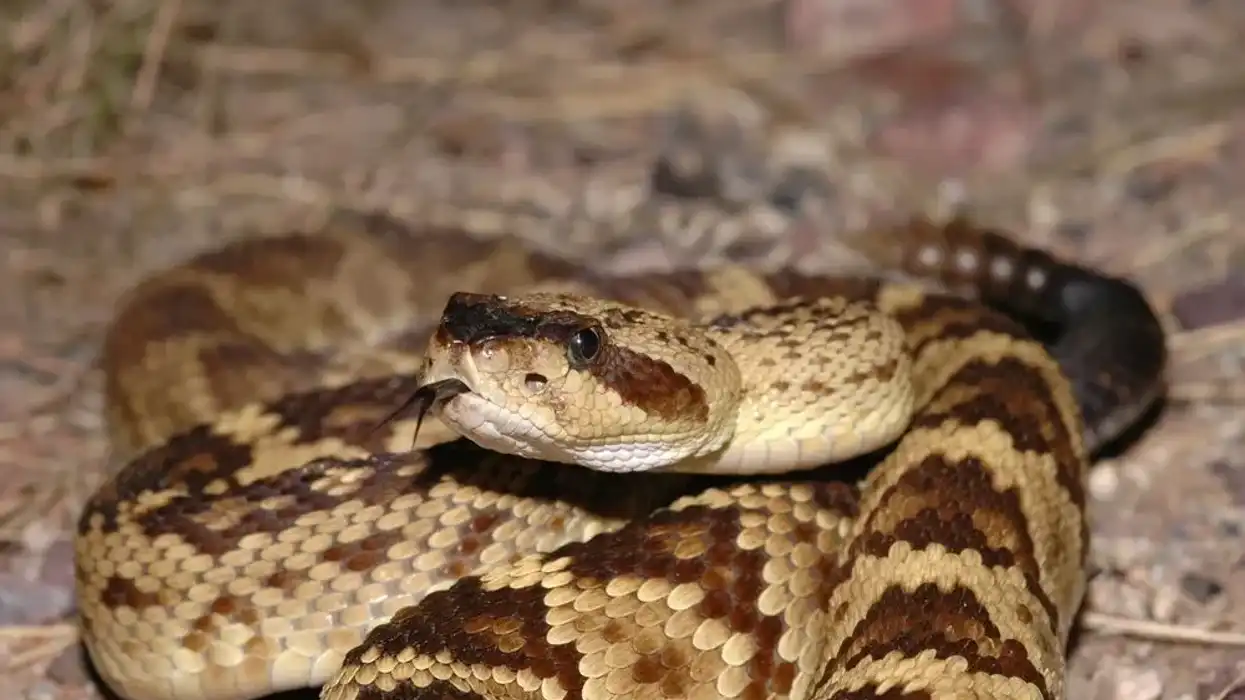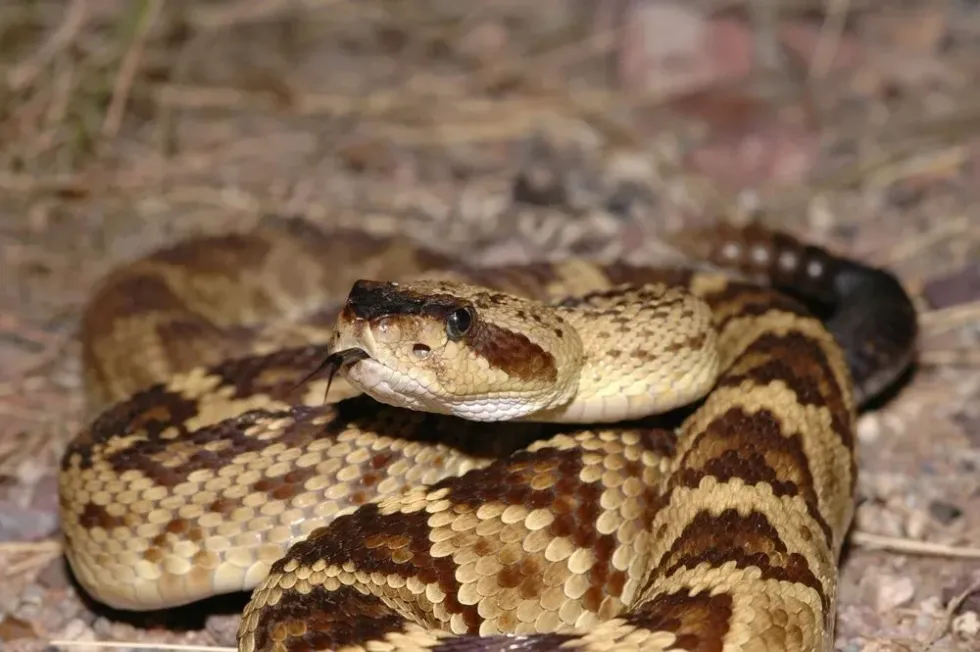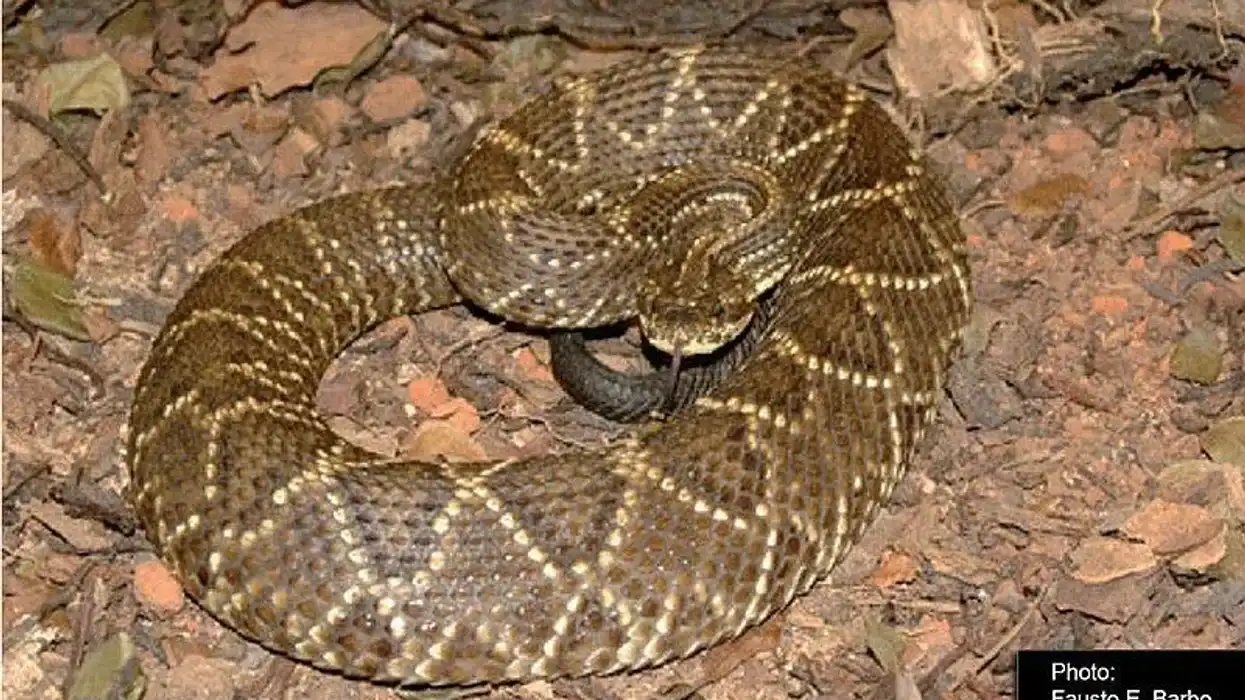Fun Black-tailed Rattlesnake Facts For Kids

The black-tailed rattlesnake (Crotalus molossus), is also known as green rattler, mountain diamondback, these snakes are found in Mexico and the southwestern United States.
It is a medium-sized pit viper species who are extremely venomous and the coloration of these snakes range from olive green to yellow and from black to brown.
As their name suggests, the only feature that differentiates these venomous rattlesnake species from other rattlesnakes is the black tail scale. Another unique feature of these rattlesnakes is that they have a black stripe across their eyes which stretches crosswise to the corner of their mouth giving an appearance of a facial mask.
The rattle on the end of the tail of these snakes is composed of keratin and every time these snakes shed their skin a fresh new section of the rattle is added up which is extremely weak and can be easily broken.
Black-tailed rattlesnakes occur in the various parts of southwestern United States which include New Mexico, Arizona, central and west Texas, and in Mexico till south in Oaxaca. These rattlesnakes can also be found in the Gulf of California.
There are three recognized subspecies of the black-tailed rattlesnakes which are found in Mexico and San esteban Island known as the Crotalus molossus nigrescens, Crotalus molossus estebanensis, and Crotalus molossus molossus.
If you liked these true facts about black-tailed rattlesnake, then you'll surely like these facts about sea snake and western diamondback rattlesnake too!
Black-Tailed Rattlesnake Interesting Facts
What type of animal is a black-tailed rattlesnake?
The black-tailed rattlesnake (Crotalus molossus) is one of the most venomous pit viper snake species.
This species changes it habit according to the climatic changes, they are diurnal during the spring season and turn nocturnal during the summer season to avoid the sun and hibernate during the winter season.
These rattlesnakes are solitary in nature and spend most of their time hidden with the help of their camouflaging skin color, though they mostly spent their time on the ground they are very good at climbing trees as well.
Black-tailed rattlesnake is found in places where it is easier for them to avoid their predators and if they are confronted by any predators they will simply slither away and hide rather than going against predators.
What class of animal does a black-tailed rattlesnake belong to?
Black-tailed rattlesnake (Crotalus molossus) is rattlesnake that belongs to the family of reptilia.
How many black-tailed rattlesnakes are there in the world?
Unfortunately, it is impossible to determine the total population of the black-tailed rattlesnake species in the world.
Where does a black-tailed rattlesnake live?
Black-tailed rattlesnake (Crotalus molossus) inhabits the savannahs, grasslands, rocky regions, desert areas, and high-altitude forests.
What is a black-tailed rattlesnake's habitat?
Black-tailed rattlesnake (Crotalus molossus) have a vast range of habitats, which includes the United States and Mexico. These rattlesnakes can be found from western to central Texas, New Mexico, Arizona, and also the nearby island from the Gulf of California.
Who do black-tailed rattlesnakes live with?
Similar to other rattlesnake species the black-tailed rattlesnake (Crotalus molossus) is a solitary species. These rattlesnakes have been seen sharing their nesting space with other snake species and to other rattlesnake species during the winter season when they are hibernating.
How long does a black-tailed rattlesnake live?
The average lifespan of a black-tailed rattlesnake (Crotalus molossus) in the wild is 15 - 20 years. In captivity, however, by providing proper care and adequate diet to these rattlesnakes they can live up to 25 years.
How do they reproduce?
The breeding season of these black-tailed rattlesnakes occurs in the spring season and they form a monogamous mating system for the period. Once a female is ready to mate, it will release a chemical trail to attack a male.
After finding a suitable female, males tap their chin down on the female's spine while wagging their tongue on the female's skin and then sexually mate. Once the pair has finished mating, the male will protect the female from other prospective mates.
These rattlesnakes reach their sexual maturity by the age of four years old, they are ovoviviparous and the female gives birth to live young snakelet. As these rattlesnakes are solitary in nature females do not stay with their young ones for longer, they lack maternal care.
What is their conservation status?
Black-tailed rattlesnakes are listed as a species of Least Concern on the IUCN Red List, due to the vast presence of these species in the United States and Mexico. In the future, the conservation status of these species may change due to the changes incurred by both humans and the nature of their natural habitat.
Black-Tailed Rattlesnake Fun Facts
What do black-tailed rattlesnake look like?
There are a series of rattles on the end of the tail of Crotalus molossus, the black-tailed rattlesnake mostly ranges in color from olive green to yellow and brown to black body with a totally black tail. The distinguishing feature of these rattlesnakes is the black stripe that extends from their eyes till the corner of their mouth.
Similar to many other rattlesnake species these snakes also have series of dark vertical stripes.
This species of rattlesnake shows reverse sexual dimorphism, females are slightly larger and heavier than males with thicker tails. Black-tailed rattlesnakes are pit vipers species, behind each of their nostrils a heat-sensing pit is located which helps these rattlesnakes to detect heat and temperature emitted by the animals.
This helps them to identify whether the animal in form of is prey or a predator.
How cute are they?
Black-tailed rattlesnakes are super cute and are known for their docile nature! Though baby black-tailed rattlesnakes look cute it doesn't mean that they are not dangerous, these rattlesnakes are born with venom and even a snakelet can inject venom if it bites you. Adult black-tailed rattlesnakes look outright scary and dangerous, with their deadly strike, and scary-looking fangs.
How do they communicate?
The most common way for communication in these rattlesnakes is the use of their tongues to detect chemical taste and scent. Black-tailed rattlesnakes use various forms of communication to thwart off predators or anything they assume can be a threat to them.
They will rattle their tails loudly to give a warning sign, and if it does not help, they will hiss loudly and then make a flicking action with the tongue. This snake will coil their bodies in an attempt to appear larger.
How big is a black-tailed rattlesnake?
An adult black-tailed rattlesnake can grow up to 30-42 in (76-107 cm) in length and only a few individuals can surpass up to 49.2-51 in (125-129.5 cm). These black-tailed rattlesnakes are double the size of the pygmy rattlesnake.
How fast can a black-tailed rattlesnake move?
Unfortunately, there is no accurate data available on the moving speed of the black-tailed rattlesnake.
How much does a black-tailed rattlesnake weigh?
An adult black-tailed rattlesnake can grow up to 14.9-24 lb (6.8-10.9 kg) in weight, females of this species are slightly heavier than males.
What are the male and female names of the species?
No particular name has been assigned to either of the sexes.
What would you call a baby black-tailed rattlesnake?
No particular name has been given to a baby Crotalus molossus, black-tailed rattlesnake babies are called hatchlings or snakelets. Once females give birth to snakelets, it abandons them within few hours or a day.
What do they eat?
Black-tailed rattlesnake are carnivorous creatures. Usually, these rattlesnakes feed on birds, small mammals, rodents, small reptiles, and amphibians.
While foraging, these rattlesnakes use their heat-sensitive organs to detect infrared heat emitting from their prey and flick their tongue to detect scents from their surroundings.
These rattlesnakes grab their prey with the help of their two hollow fangs and as soon as the fangs penetrate the skin a lethal venom is released in the bodies of their prey killing them immediately.
A northern black-tailed rattlesnake can go without eating for about two weeks on an average, and it mostly depends on the size of their last prey.
Are they poisonous?
Black-tailed rattlesnakes are venomous creatures! A bite from these rattlesnakes can be dangerous but not fatal.
The venom from these black-tailed rattlesnakes can become fatal only if the wound is left untreated. The venom can cause serious damage to the tissues as it kills the skin tissue and blood cell and affects the circulating system resulting in an internal hemorrhage. Even a black-tailed rattlesnake snakelet bite contains enough venom to become fatal if not treated.
The treatment for Arizona black-tailed rattlesnake bite starts with less physical exertion and remaining calm because the venom injected in your body is potentially deadly, it should be kept in mind that an anti-venom should be provided to the victim within two hours from the time they were bitten.
The venom of black-tailed rattlesnake can be easily neutralized with the help of Polyvalent antivenom.
Would they make a good pet?
Black-tailed rattlesnakes species are the most docile rattlesnakes, which makes it easier to keep them as pets. It is very easy to replicate the habitat of these species for them to thrive in and provide a meat-based diet by providing rodents, lizards, and small amphibians.
It does not change the fact that snakes are a difficult pet to keep, and some may disagree with keeping these wild animals as pets. However, if you live in Arizona, it is illegal to keep any venomous snake as a pet.
Did you know...
Many snake species and other reptile species are oviparous and lay eggs to produce young snake, but all rattlesnake species are ovoviviparous in nature and usually, the female gives birth to live snakes.
The northern black-tailed rattlesnake occupies various ranges of elevation and habitat, this black-tailed rattlesnake is found at up to 12,000 ft (3657.6 m) elevation.
An extra layer of the rattle is added every time a northern black-tailed rattlesnake sheds its old skin, which is made up of keratin and can be easily broken. By looking at the rattles it is somewhat possible to tell the age of an individual.
Similar to a cat's eye, rattlesnakes also have a vertical pupil in their eyes. This feature helps the rattlesnakes to ambush their prey both day and night.
How many rattlesnakes live in Arizona?
North and South America is the home of 36 rattlesnake species and out of 36 species 13 rattlesnake species are found in Arizona, the most encountered once are the Mojave, sidewinder, black-tailed, and western and eastern diamondback rattlesnakes.
Can a rattlesnake have a black tail?
Black-tailed rattlesnakes are the only rattlesnake that has a completely black tail other than the diamondback rattlesnake that has a black band on their white tail.
Here at Kidadl, we have carefully created lots of interesting family-friendly animal facts for everyone to discover! Learn more about some other reptiles from our timber rattlesnake or prairie rattlesnake.
You can even occupy yourself at home by coloring in one of our free printable snake coloring pages.
The second image is by Patrick Alexander.
We Want Your Photos!
More for You
Bachelor of Arts specializing in Journalism and Mass Communication, Postgraduate Diploma in Sports Management

Moumita DuttaBachelor of Arts specializing in Journalism and Mass Communication, Postgraduate Diploma in Sports Management
A content writer and editor with a passion for sports, Moumita has honed her skills in producing compelling match reports and stories about sporting heroes. She holds a degree in Journalism and Mass Communication from the Indian Institute of Social Welfare and Business Management, Calcutta University, alongside a postgraduate diploma in Sports Management.
Bachelor of Arts specializing in English Literature, Masters of Art specializing in English and Communication Skills

Sonali RawatBachelor of Arts specializing in English Literature, Masters of Art specializing in English and Communication Skills
Sonali has a Bachelor's degree in English literature from Guru Gobind Singh Indraprastha University and is currently pursuing a Master's in English and Communication from Christ University. With considerable experience in writing about lifestyle topics, including travel and health, she has a passion for Japanese culture, especially fashion, and anime, and has written on the subject before. Sonali has event managed a creative-writing festival and coordinated a student magazine at her university. Her favorite authors are Toni Morrison and Anita Desai.
Disclaimer
1) Kidadl is independent and to make our service free to you the reader we are supported by advertising. We hope you love our recommendations for products and services! What we suggest is selected independently by the Kidadl team. If you purchase using the Buy Now button we may earn a small commission. This does not influence our choices. Prices are correct and items are available at the time the article was published but we cannot guarantee that on the time of reading. Please note that Kidadl is a participant in the Amazon Services LLC Associates Program, an affiliate advertising program designed to provide a means for sites to earn advertising fees by advertising and linking to Amazon. We also link to other websites, but are not responsible for their content.
2) At Kidadl, we strive to recommend the very best activities and events. We will always aim to give you accurate information at the date of publication - however, information does change, so it’s important you do your own research, double-check and make the decision that is right for your family. We recognise that not all activities and ideas are appropriate for all children and families or in all circumstances. Our recommended activities are based on age but these are a guide. We recommend that these ideas are used as inspiration, that ideas are undertaken with appropriate adult supervision, and that each adult uses their own discretion and knowledge of their children to consider the safety and suitability. Kidadl cannot accept liability for the execution of these ideas, and parental supervision is advised at all times, as safety is paramount. Anyone using the information provided by Kidadl does so at their own risk and we can not accept liability if things go wrong.
3) Because we are an educational resource, we have quotes and facts about a range of historical and modern figures. We do not endorse the actions of or rhetoric of all the people included in these collections, but we think they are important for growing minds to learn about under the guidance of parents or guardians.







